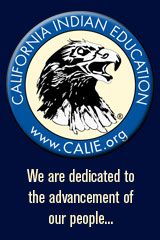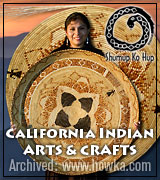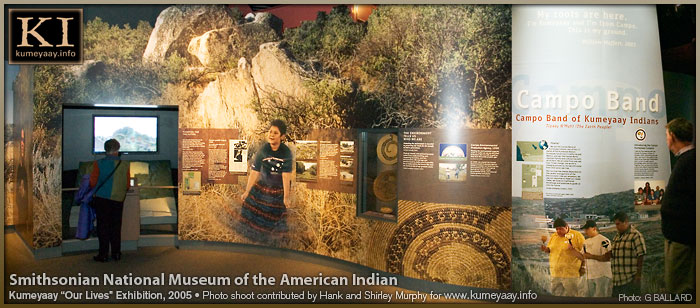|
THE KUMEYAAY
by Michael Baksh
SUBSISTENCE | HOUSING & TECHNOLOGY | SETTLEMENTS & SEASONAL ROUND | KUMEYAAY AGRICULTURE | SOCIAL ORGANIZATION | TRADE | SPIRITUAL LIFE
INTRODUCTION
This ethnographic overview focuses on the Kumeyaay of southern San Diego County. It is based upon the detailed descriptions and research findings of several important ethnohistorical and ethnographic studies. Important sources that document this region's Native Americans include Spier's Southern Diegueño Customs (1923), Kroeber's Handbook of The Indians of California (1925), Gifford's The Kamia of Imperial Valley (1931), and Lee's Indians of the Oaks (1978 [original 1937]). More recent studies that include important ethnographic descriptions and analyses include Hedges's Santa Ysabel Ethnobotany (1967), and Shipek's History of Southern California Mission Indians (1978). A critical source of ethnographic information is Cuero's The Autobiography of Delfino Cuero: A Diegueño Women (1970).
Useful overviews of local ethnography include Almstedt's The Kumeyaay and 'lipay (1982) and Townsend's Prehistoric Lifeways in the Jacumba Valley (1986), and additional bibliographical material on the Kumeyaay is available in Almstedt's Bibliography of the Diegueño Indians (1974) and Bean and Vane's California Indians: Primary Sources (1977).*
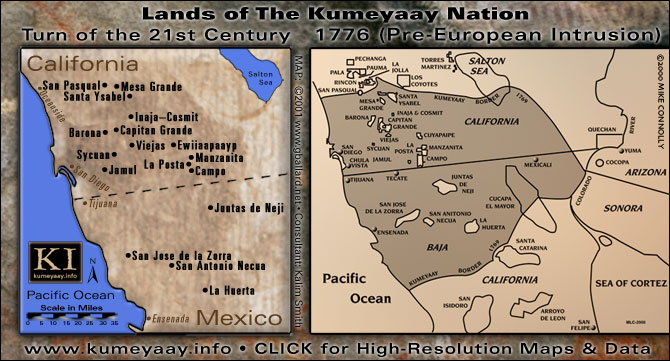
Right map highlights the Kumeyaay ancestral territory in gray prior to European immigration — the dots on the modern left map show present-day locations of the 13 small Kumeyaay Indian reservations in the United States, and four Kumiai Indio tribal community ranches in Baja California, Mexico, at the turn of the 21st century.
As noted earlier, at the time of European contact in the late 1700's, ancestors of the modern-day Kumeyaay (Southern Diegueño) Indians occupied an area that presently includes southern San Diego County, the southern two-thirds of Imperial County, and northern Baja California. A distinction is often made between mountain and desert inhabitants, restricting use of the name "Kumeyaay" to groups living in the mountains and near the coast, and applying the term "Kamia" to the desert-oriented groups (see Hedges 1975 for a thorough discussion). The closely-related Ipai or 'lipay (Northern Diegueño) were to the northwest. According to Spier, the relations of the Southern Diegueño "with the Northern Diegueño were intimate: intermarriage may have been common" (1923:298). Other Yuman-speakers, namely the Quechan and the Cocopah, lived to the east. To the northeast were the Cahuilla, a Shoshonean language population and occasional enemy of the Diegueño groups.
From a historical perspective, European contact represented the end of the region's archaeologically-known "Late Prehistoric Period". This final period of prehistoric occupation in San Diego and Imperial counties was characterized by a hunting and gathering economy, with a heavy emphasis on the exploitation of acorns in the mountains and mesquite beans in the desert.
Unlike most hunter-gatherer populations, the Yuman groups had a ceramic technology, and some made limited use of agriculture. At least a few settlements were "permanently" occupied (Wallace 1955:221), although settlement practices were clearly dictated by the distribution and availability of critical resources. The overall population density for the region was probably less than one person per square mile, based upon the observation of other forager societies.
Although contact with missionaries, explorers, settlers and others ultimately led to profound changes in adaptation, world view, and other cultural domains, the knowledge and early experiences of many contemporary Kumeyaay give valuable insight to the nature of the "traditional" Kumeyaay culture (see, for example, Cuero 1970). The following summary is an effort to describe Kumeyaay culture as it existed for several hundred years before contact and until major changes occurred in the 1800's.
SPIRITUAL LIFE
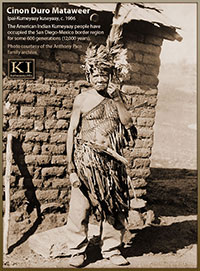 The Kumeyaay experienced a rich spiritual or religious life. All religions serve to reduce anxiety by explaining the unknown and making it understandable, provide comfort in the belief that supernatural aid is available in times of crisis, sanction a wide range of human conduct by providing notions of right and wrong, maintain social solidarity, and enhance the learning of oral traditions. The Kumeyaay experienced a rich spiritual or religious life. All religions serve to reduce anxiety by explaining the unknown and making it understandable, provide comfort in the belief that supernatural aid is available in times of crisis, sanction a wide range of human conduct by providing notions of right and wrong, maintain social solidarity, and enhance the learning of oral traditions.
As hunter-gatherers who saw themselves as being a part of nature rather than superior to it, the Kumeyaay maintained a belief system known as animism.
Animism basically involves a belief in spirit beings which are thought to animate nature. Related to this, animals are especially important in mythology, taboos, and ceremonial practices. Specific examples of Kumeyaay supernatural beliefs and characteristics associated with particular animals and birds are provided by Sparkman (1908), Waterman (1910), Spier (1923), and Cuero (1970), but in general little is known about this society's religious beliefs and practices. It is known, however, that their religion was essential to the overall adaptation and well-being of prehistoric and historic Kumeyaay Indians, and that violations of current beliefs, practices, or sites of religious importance could impair the health and well-being of Kumeyaay living today.
SUBSISTENCE
The Southern California region provided Native Americans a source of various foods, construction materials, medicines and other resources. Strategies for procuring wild foods included hunting, fishing, and gathering. Large game such as deer, mountain sheep, and antelope were hunted, but greater reliance was placed upon rabbits, ground squirrels, woodrats, and other small animals, and upon pigeons, doves, larks, robins, quail and other birds (a comprehensive list of faunal resources is provided in Farrell 1978), which provided most of the meat in the diet (Luomala 1978:601; Spier 1923:335, 337).
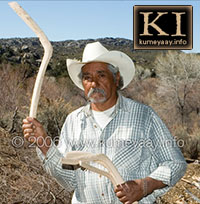 Game animals and birds were hunted by bow and arrow. Traps, clubs, throwing sticks, and nets (constructed of yucca fiber) were other important items used to capture game, especially small animals (Cuero 1970; Sparkman 1908). For example, traps baited with acorns were used to capture ground squirrels, rats, mice and other small animals, and nets were used to capture rabbits. Most hunting was done alone or by a few individuals, although communal hunts such as rabbit drives were conducted when large numbers of animals were available. Game animals and birds were hunted by bow and arrow. Traps, clubs, throwing sticks, and nets (constructed of yucca fiber) were other important items used to capture game, especially small animals (Cuero 1970; Sparkman 1908). For example, traps baited with acorns were used to capture ground squirrels, rats, mice and other small animals, and nets were used to capture rabbits. Most hunting was done alone or by a few individuals, although communal hunts such as rabbit drives were conducted when large numbers of animals were available.
The Kumeyaay also exploited local streams and the Pacific coast. Mountain trout were caught by poisoning pools with the juice of a plant, and an unidentified smaller fresh water fish was caught with a dip net (Sparkman 1908). People living along the coast consumed large amounts of seafood. Clams, abalone, scallops, starfish, octopus and other marine life were collected from lagoons and tide pools (Cuero 1970:28-29, 56-57; Sparkman 1908; Alvarez 1976), and grunion were gathered during runs (Cuero 1970:29-30). Boats made of reeds (Cuero 1970) and wood (Sparkman 1908) were used for offshore fishing; fish were caught with abalone shell hooks and yucca fiber line, as well as with agave or yucca fiber nets and spears made with cactus thorns (Cuero 1970:29; Sparkman 1908).
In addition to exploiting local streams and the Pacific coast, Southern California hunter-gatherers also procured resources from along the shoreline of Lake Cahuilla in Imperial Valley. This freshwater lake rose and fell three times in the last 2,000 years, with the most recent stand being about 1300-1500 A.D. (Wilkie 1978:45-53). The lake represented an environment rich in aquatic and other resources; shellfish and several varieties of fish were exploited, as were several varieties of economically important marshland plants (Schaefer 1986:9-10). Land animals and birds attracted to the lake were presumably hunted along the shoreline as well.
As with most forager and other subsistence-based societies, faunal foods provided the Kumeyaay with important supplies of protein and fat, but the bulk of the diet in terms of caloric intake was provided by plant foods. A wide variety of edible seeds, nuts, beans, fruits and other plant foods were available in Kumeyaay territory (see Farrell 1978 for details on plant uses by inland San Diego County Indians).
As with most California Indians, the acorn (from several species of Quercus) was the single most important food source for the Kumeyaay, at least for groups in the mountains. Acorns are very high in caloric value as well as fat content (Bean and Saubel 1972:125-126). White estimated that for the Luiseño, located to the north and very similar to the Kumeyaay in terms of subsistence practices, acorns provided almost 50 percent of the diet (1963:121). The reliance upon acorns at any given time was largely a consequence of seasonal availability: acorns were gathered in October and November and were eaten in greatest amounts during these and subsequent months, although nuts were also stored (Spier 1923:334) and likely available for most if not the entire year.
Other major plant foods included agave (Agave deserti), pine nuts (Pinus monophylla and P. quadrifolia), and mesquite beans (Prosopis juliflora and P. pubescens). Agave is abundant in the lower foothills and on the sides of the mountains facing the desert. The plant provides several foods including the flower bud or mescal head, leaves or stalks, blossoms, and seeds. Because various parts of the plant are edible, it was exploited as a food resource for much the year, although major collecting and processing activities occurred in the early spring (Bean 1972:41).
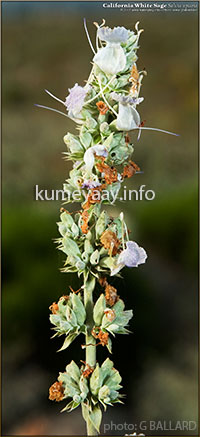 For the Kamia Indians (and the Kumeyaay living near the desert), the mesquite bean was the major staple. The tree usually grows at elevations below 3,000 feet and in large sandy wash areas where the water table is high. The blossom, the green pod (which looks much like a pea pod) and the dried pods were all collected from the mesquite trees. Blossoms are available in June and seed pods in July and August, and "the trees yielded large quantities of food on a dependable basis year after year" (Bean 1972:38). Delfina Cuero, who was born at Jamacha around 1900 and resided regularly in the Jamul area, traveled every year with her family to Mexicali, Mexico, to collect mesquite beans (1970:58). For the Kamia Indians (and the Kumeyaay living near the desert), the mesquite bean was the major staple. The tree usually grows at elevations below 3,000 feet and in large sandy wash areas where the water table is high. The blossom, the green pod (which looks much like a pea pod) and the dried pods were all collected from the mesquite trees. Blossoms are available in June and seed pods in July and August, and "the trees yielded large quantities of food on a dependable basis year after year" (Bean 1972:38). Delfina Cuero, who was born at Jamacha around 1900 and resided regularly in the Jamul area, traveled every year with her family to Mexicali, Mexico, to collect mesquite beans (1970:58).
Included among the numerous other plant foods eaten by the Kumeyaay were yucca (Y. schidigera and Y. whipple), wild plum (Condaliopsis parryi), desert apricot (Prunus fremontii), various grasses, black and white sage seeds and leaves (Salvia apiana and S. columbariae), goosefoot (Chenopodium L. spp.), beavertail cactus (Opuntia basilaris), cholla cactus (Opuntia spp.) and prickly pear cactus (Opuntia spp.) (Luomala 1978:600; Spier 1923:335-336).
Additionally, manzanita and holly-leaf cherry provided a fruit and a seed that could be ground into a meal (Hedges 1967:34; Bean and Saubel 1972:41; Sparkman 1908:194-230); elderberry, toyon berries, and various greens were eaten; and beverages were made from manzanita (Cuero 1970:31; Bean and Saubel 1972:40-41), lemonadeberry (Bean and Saubel 1972:132), cana (Hedges 1967:19; Bean and Saubel 1972:70), and sugar bush and basketweed berries (Bean and Saubel 1972).
All Native Americans used plants for a wide variety of medical purposes including colds, influenza, respiratory problems, fevers, gastric disorders, diarrhea, infections, sprains, sore muscles, minor cuts, and headaches. The Kumeyaay prepared medicines from white sage, California sagebrush, elderberry blossoms, holly-leaf cherry bark, buckwheat leaves and flowers, manzanita leaves, scrub oak, mistletoe, chamise, and cottonwood leaves, among other plants. Details on the medical uses of plants are provided by Hedges (1967) Bean and Saubel (1972), and also by Cuero (1970), Sparkman (1908), and Lee (1978).
HOUSING AND TECHNOLOGY
Aside from depending upon the local environment for adequate supplies of nutritious food, the Kumeyaay were also dependent upon the availability of local raw materials for the manufacture of critical utilitarian items. Houses, clothes, bows and arrows, containers, and food preparation implements are but a few of the indispensable items that virtually all hunter-gatherer populations must manufacture to achieve and maintain a good quality of life, and the Kumeyaay clearly had both the knowledge and raw materials necessary to make these and other items.
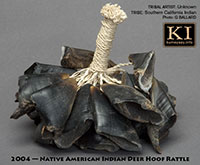 Plant materials, animals, and stone provided the raw materials for most manufactured items. For example, houses, fiber and thatching were constructed from willows, oak, manzanita, deer weed, and chamise (Bean and Saubel 1972:29-31; Lee 1978:59; Cuero 1970:25; Spier 1923:338), and a very durable, multi-purpose fiber was manufactured from yucca (Cuero 1970; Bean and Saubel 1972; Lee 1978; Spier 1923). Plant materials, animals, and stone provided the raw materials for most manufactured items. For example, houses, fiber and thatching were constructed from willows, oak, manzanita, deer weed, and chamise (Bean and Saubel 1972:29-31; Lee 1978:59; Cuero 1970:25; Spier 1923:338), and a very durable, multi-purpose fiber was manufactured from yucca (Cuero 1970; Bean and Saubel 1972; Lee 1978; Spier 1923).
Clothing such as robes or capes for cold weather, as well as blankets, were made primarily from rabbit skins, although buckskin and sea otter skin were also used (Sparkman 1908; Spier 1923). Shoes and sandals were commonly made of agave or yucca fibers, buckskin, and, since European contact, cowhide (Cuero 1970:56; Spier 1923). Headbands were made of feathers from ravens, owls, hawks, golden eagles, bald eagle, and condors, and other adornments such as necklaces, bracelets, hairpins, and nose plugs were made variously of mammal bones, deer hoofs, bear claws, and several shells including Donax (bean clam), Chione (Venus clam), Olivella, and Haliotis (abalone) (Sparkman 1908; Alvarez 1976).
 Bows and arrows were indispensable for hunting and, at times, for protection from others. Bows were made from willow (Salix L.) (Curtis 1926:44; Spier 1923:350), screw bean mesquite (Prosopis pubescens), and mountain ash (Spier 1923:350). According to Spier (1923:351), arrows were "made of arrowweed provided with wooden foreshaft, or entirely of wood. The latter (being) more effective against big game." Fire-hardened greasewood was also used to make arrows for hunting big game (Curtis 1926:45), as were stone projectile points (Spier 1923:352). Quartz and metavolcanics were available throughout much of Kumeyaay territory, whereas obsidian, chert, chalcedony, steatite and other lithics occurred in more localized areas and were sometimes acquired through exchange. Bows and arrows were indispensable for hunting and, at times, for protection from others. Bows were made from willow (Salix L.) (Curtis 1926:44; Spier 1923:350), screw bean mesquite (Prosopis pubescens), and mountain ash (Spier 1923:350). According to Spier (1923:351), arrows were "made of arrowweed provided with wooden foreshaft, or entirely of wood. The latter (being) more effective against big game." Fire-hardened greasewood was also used to make arrows for hunting big game (Curtis 1926:45), as were stone projectile points (Spier 1923:352). Quartz and metavolcanics were available throughout much of Kumeyaay territory, whereas obsidian, chert, chalcedony, steatite and other lithics occurred in more localized areas and were sometimes acquired through exchange.
With a diet based upon acorns and other plant foods that required grinding and pounding as steps of food preparation, stone mortars, pestles, and other milling stones were fashioned from locally available materials. Appropriate lithic materials were generally available throughout Kumeyaay territory; as recalled by Cuero: "As I roamed the mountains looking for food, I have seen lots of grinding holes in the rocks everywhere" (1970:58).
Although grinding implements often did not require elaborate preparation, many tools were portable and/or represented such significant investments of manufacture time that they were prized enough to be transported between various settlements and work sites. Again, Cuero: "We always carried some grinding stones and some other tools with us. A lot of stones you could pick up any place and make what you needed." (1970:30). Millingstones are, understandably, one of the most commonplace artifacts found in the Kumeyaay archaeological record. As described in a section of this report, the Rancho Jamul study area was used extensively for milling activities.
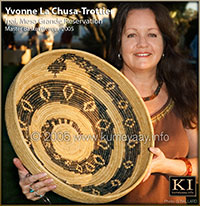 Carrying devices and containers for storing water, food, and other items are critical for hunting and gathering peoples due to high settlement mobility and the need to carry foods back to the camp or home base (Lee 1979:147). The Kumeyaay made baskets and thatching from basket weed, bunch or deer grass, willow, and juncus (Merrill 1973), and made storage vessels and granaries from scrub oak, chamise, and coffeeberry (Cuero 1970; Hedges 1967; Bean and Saubel 1972; Lee 1978). Carrying devices and containers for storing water, food, and other items are critical for hunting and gathering peoples due to high settlement mobility and the need to carry foods back to the camp or home base (Lee 1979:147). The Kumeyaay made baskets and thatching from basket weed, bunch or deer grass, willow, and juncus (Merrill 1973), and made storage vessels and granaries from scrub oak, chamise, and coffeeberry (Cuero 1970; Hedges 1967; Bean and Saubel 1972; Lee 1978).
Ceramics used for food preparation, storage, and transportation were made from clay obtained from various sources extending from the mountains to the Colorado River area (see Woods 1982:Appendix A, for some local sources). Throughout her autobiography, Cuero refers to an array of food preparation and carrying containers and other devices. In one passage she recounts that "we used to carry loads on our backs with bags made of agave fiber. We used big gourds for dishes and for storing stuff as well as ... clay dishes ... and ollas, and different shaped baskets" (1970:31).
SETTLEMENTS AND THE SEASONAL ROUND
As hunter-gatherers, the Kumeyaay moved around a great deal. Such movement was not aimless wandering, but rather, was dependent upon the availability of wild foods and water within one's territory. Like most hunter-gatherer peoples, the procurement of wild foods by the Kumeyaay was characterized by an opportunistic strategy. That is, whereas hunter-gatherers often set out purposefully to hunt or collect a particular variety of animal, bird, plant or other resource, such trips commonly yielded other foods or raw materials. As recalled by Cuero, "no matter what we were gathering, I always looked for herbs and other greens where ever we were" (1970:58).
Seasonality and clan membership were therefore two major factors that influenced one's location at any given time. As described by Almstedt, "each clan was associated with a particular territory which included all the area from which the group derived subsistence during the course of an annual cycle" (1982:13).
More specifically, according to Loumala, a clan's seasonal travel was vertical, following the ripening of major plants from canyon floor to higher mountain slopes.... After months of preserved vegetal food and limited game, March through May provided welcome buds, blossoms, and potherbs from canyons and lower foothills.
Some people left in May for agave.... In early June they dried ripening cactus fruits to store in foothill caves. From June through August wild seeds ripened, and at higher altitudes wild plums and other fruits.... Men, women, and children worked far into the night from September to November in higher altitudes to gather and preserve acorns and sometimes piñon nuts (1978:599).
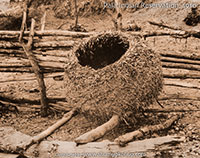 Although clans moved from place to place within their general territory, some locations were occupied for longer periods and by more people than others (Almstedt 1982:13). These settlements, which may be regarded as villages, "were places to which the people returned from their foraging, where they spent winter months, sometimes in association with other clans.... Some larger groups appear to have had sizable summer as well as winter villages" (Almstedt 1982:13). Within each village there was a dance floor, extensive milling stations, family living areas, and possibly a sweathouse and granary. If it was a winter camp, a house would have been set directly on the ground and a fireplace built on the ground by the door (Spier 1923:338). The Kumeyaay did not make summer houses (Spier 1923:338). Instead, "the summer village needed only a windbreak, trees, or a cave fronted with rocks" (Luomala 1978:597). Although clans moved from place to place within their general territory, some locations were occupied for longer periods and by more people than others (Almstedt 1982:13). These settlements, which may be regarded as villages, "were places to which the people returned from their foraging, where they spent winter months, sometimes in association with other clans.... Some larger groups appear to have had sizable summer as well as winter villages" (Almstedt 1982:13). Within each village there was a dance floor, extensive milling stations, family living areas, and possibly a sweathouse and granary. If it was a winter camp, a house would have been set directly on the ground and a fireplace built on the ground by the door (Spier 1923:338). The Kumeyaay did not make summer houses (Spier 1923:338). Instead, "the summer village needed only a windbreak, trees, or a cave fronted with rocks" (Luomala 1978:597).
KUMEYAAY AGRICULTURE
The extent to which the Kumeyaay practiced agriculture at the time of European contact has not been established. Gifford (1931) felt that agriculture, which had been well established among the Colorado River groups at the time of Western influence, had diffused into the Imperial Valley and was practiced by all of the Kamia lineages. Similarly, Lawton and Bean (1968) have suggested that certain Cahuilla groups cultivated corn, beans, squash and melons, like the neighboring Colorado River tribes. There is some evidence suggesting that Indians may have planted yucca in the Sycamore Canyon area (Woods 1982:A1-5, A2-9), and crops were at some time planted and irrigated in the Jacumba Valley (Woods 1982:A1-7, A2-13).
In any case, although the Kumeyaay were dependent upon wild foods at European contact, a shift in subsistence had apparently started in the sense that at least some techniques of incipient agriculture were being practiced in some areas. Foragers have rarely practiced irrigation agriculture (the Shoshone were an exception; see Steward 1930), and it may be that the irrigation techniques used by the Kumeyaay were a post-contact influence introduced by Kumeyaay neophytes from Mission San Diego de Alcalá (Gifford 1931). Regardless of whether irrigation and other forms of agriculture were being practiced at the time of contact, agricultural food production techniques were certainly utilized by the Kumeyaay in the 1800's. Of importance, a cached pot dating to this period containing sorted seeds that presumably were intended to be planted was found near Jacumba (Treganza 1947).
SOCIAL ORGANIZATION
Group size and the degree of social interaction therefore varied over the course of an annual cycle. The basic unit of production was the family, which was capable of great self-sufficiency, but Kumeyaay families, like other hunter-gatherers, moved in and out of extended family camps or villages opportunistically as problems or opportunities arose. Thus, whereas single families occasionally exploited low-density, dispersed resources on their own, camps or villages of several families formed at other times, particularly when key resources (such as water) were highly localized.
Going beyond the basic social unit of the family, the Kumeyaay were organized by some form of descent system. From the available ethnographic data it is not immediately obvious as to whether they were organized into lineages or clans. Indeed, their features of social organization appear to have shared some qualities of both systems, and it may be speculated that the society had begun evolving from a lineage system to a clan system prior to the time of Western contact.
In any case, the Kumeyaay traced their descent patrilineally (i.e., through one's father), were exogamous at the level of the descent group (i.e., one had to marry outside one's own lineage or clan), and practiced patrilocal residence (i.e., a married woman lived with her husband's father's relatives). Descent groups apparently "owned" land and certain other resources. According to Kroeber, "It would appear that each "clan" owned a tract and that each locality was inhabited by members of one clan, plus their introduced wives" (1925:720).
Regarding other resources, Spier observed that some "gens" (i.e., clans) owned patches of certain trees and "Each gens owned one or more eyries from which eaglets were taken for use in the mourning ceremony" (1923:307). Apparently, however, resource ownership did not extend to the oak groves in the mountains (ibid), which probably reflects the extreme importance placed upon this resource for the adaptation and survival of the entire society.
Ethnohistorical and ethnographic data available for the Kumeyaay indicate that they practiced a sexual division of labor typical for hunter-gatherer populations. Most basically, men were hunters and women were gatherers, although it is clear that men sometimes gathered wild foods and women occasionally caught small animals. The female gatherer likely provided the bulk of the calories; women in foraging societies typically provide 60-70% of the diet (Haviland 1987:157). Aside from hunting, men were likely responsible for manufacturing certain tools and other items, and for performing a variety of political, economic, and ceremonial functions.
Women were especially responsible for child care, food production, and the manufacture of many indispensable items. One early visitor to Kumeyaay villages described women as the "chief laborers" (Bartlett 1854:122). For certain activities there was overlap or cooperation. For example, "the whole family helped with gathering acorns and pine nuts" (Cuero 1970:57). In any case, men and women both made valuable contributions to survival. As described by Cuero, "the women had to do their work while the men worked too. Either we do this or we starve" (1970:31-32).
Resource exploitation and subsistence includes not only the direct acquisition of raw materials and food but also the distribution of these resources within the camp or local group. Among hunter-gatherers, the extensive sharing of meat in particular serves at least two functions. First, it contributes to a high quality diet by maximizing the occasions that all members in a group are able to consume important amounts of faunal protein and fat. And second, the sharing of meat reinforces the social relationships of a group and eliminates what might otherwise be moments of intense envy and friction when one hunter's success is contrasted with another's failure.
The Kumeyaay clearly placed an emphasis on sharing, particularly of meat. For example, Luomala (1978:599) claims that newly arrived families at a campsite would obtain their meat from the permanent residents or those who had been there for a while. In addition, young boys had to give away all their kills, and the first deer-kill of any hunter, even an adult, was distributed. Spier's (1923:336) informant, Jim McCarty, described his memorable hunting experiences with the distribution of big game to others who were present.
TRADE
The exchange of prized foods and other items between local groups and between tribes is also economically and socially important. The Kumeyaay obtained obsidian and other highly valued lithics from their neighbors, for example. And, as described by Cuero, the Kumeyaay "down near San Diego used to take lots of salt from the bay and trade it for mesquite beans and other things from the desert. They used to go a long way to trade for what they needed. There were no roads then, just trails, and we walked and carried everything on our backs. Dried sea food, pumpkins, and dried greens were traded for gourds, acorns, agave, and honey" (1970: 33).
*NOTE: Additional material will be added to this in the near future from Lora L. Cline's The Kwaaymii: Reflections on a Lost Culture, Occasional Paper No. 5, IVC Museum Society, El Centro, California, 1979. This is based on the culture of the Kumeyaay living in the Laguna Mountains east of Cuyamaca [Philip de Barros]. If the reader is interested in a copy of the references cited in this report, please contact me at pdebarros (at) palomar (dot) edu.
SOURCE (link broken): http://daphne.palomar.edu/cuyamaca/kumeyaay.htm
|


